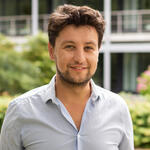Mikhail Kudryashev takes up a W2-Professorship
Since August 2021, Dr. Mikhail Kudryashev has been heading the “In situ Structural Biology” lab at the Max Delbrück Center for Molecular Medicine in the Helmholtz Association (Max Delbrück Center) – and had received funding in the Heisenberg Program of the German Research Foundation (DFG), which can be converted into a professorship. To support the young scientist in this career leap, the Max Delbrück Center, in cooperation with Charité - Universitätsmedizin Berlin, started the necessary process early. Now, Kudryashev can accept the call to a W2(S) Heisenberg professorship at Charité.
Mikhail Kudryashev is convinced that the close proximity to patients at Charité, combined with the excellent research infrastructure at the Berlin-Buch campus, will boost his research: “The opportunity to study pathological conditions of patients will be of great benefit to us.” His research focuses on the structural biology of membrane protein complexes – proteins in the lipid layer of cell membranes. Among other things, they ensure the activation of ion channels which are the main modulators of signalling in nerve and muscle cells. These control mechanisms are of interest for drug development. “Substances with the ability to switch specific proteins on or off can cure diseases or improve the quality of life”, says the biophysicist.
View into the inner cell
The opportunity to study pathological conditions of patients will be of great benefit to us.
Kudryashev and his team use modern imaging techniques such as cryo-electron microscopy (cryo-EM) and cryo-electron tomography (cryo-ET) to examine cells or their individual components in their natural state and in their cellular environment – “in situ”. For cryo-EM purified proteins or entire cells are quickly frozen to very low temperatures to form an amorphous layer of ice which can be placed in a vacuum of an electron microscope. An electron beam penetrates the sample producing transmission images that are recorded. Many two-dimensional images of a sample are converted by software into a precise three-dimensional representation known as a tomogram. Tomograms of cells provide information about the interactions of molecules inside cells and about structure of proteins in their native environment. Kudryashev’s team develops algorithms for this technically challenging process to achieve the highest possible resolution.
Proteins again and again
After he finished his studies of physics at the Krasnoyarsk State University in Russian Siberia, he investigated the protein structures of malaria parasites in the lab of Professor Friedrich Frischknecht at the University of Heidelberg. There he worked with the cryo-EM for the first time. Using this technology, the researchers succeeded in imaging the architecture of the unicellular parasites. After four years in Heidelberg, Kudryashev joined the Biozentrum at the University of Basel in Switzerland. In the lab headed up by the Professors Henning Stahlberg and later Marek Basler, he studied proteins in the membranes of bacteria. He took charge of his own group for the first time in 2015 at the Max Planck Institute of Biophysics and the Buchmann Institute for Molecular Life Sciences at Goethe University in Frankfurt am Main where he worked on the structure and activation of ion channels – a topic he is now exploring further at the Max Delbrück Center.
With the Heisenberg Professorship, the DFG recognizes the “scientific quality and originality of the research project at an international level”. With this funding, it aims to support excellent scientists preparing for an academic leadership position and to further advance their projects. Mikhail Kudryashev's next project is the first publication, which he and his team at the Max Delbrück Center are currently working on. After just eleven months.
Text: Jana Ehrhardt-Joswig






